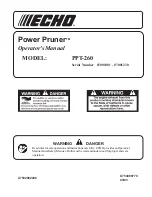
13
ENGLISH
Never reach under the work for any reason. When you have
to retract the telescoping guard manually (as is necessary
for starting pocket cuts) always use the retracting lever.
NOTE:
When cutting thin strips, be careful to ensure that
small cutoff pieces don’t hang up on inside of lower guard.
RIPPING
Ripping is the process of cutting wider boards into narrower
strips – cutting grain lengthwise. Hand guiding is more
difficult for this type of sawing and the use of a STANLEY
parallel fence (w) is recommended.
POCKET CUTTING (FIG. O)
WARNING:
Never tie the blade guard in a raised
position. Never move the saw backwards when
pocket cutting. This may cause the unit to raise
up off the work surface which could cause injury.
A pocket cut is one that is made in a floor, wall or other
flat surface.
1. Adjust the saw foot plate so the blade cuts at desired
depth.
2. Tilt the saw forward and rest front of the foot plate on
material to be cut.
3. Using the lower guard lever, retract lower blade guard
to an upward position. Lower rear of foot plate until blade
teeth almost touch cutting line.
4. Release the blade guard (its contact with the work will
keep it in position to open freely as you start the cut). Remove
hand from guard lever and firmly grip auxiliary handle (e),
as shown in Figure P. Position your body and arm to allow
you to resist kickback if it occurs.
5. Make sure the cutting surface before starting saw.
6. Start the motor and gradually lower the saw until its foot
plate rests flat on the material to be cut. Advance saw along
the cutting line until cut is completed.
7. Release trigger and allow blade to stop completely before
withdrawing the blade from the material.
8. When starting each new cut, repeat as above.
MAINTENANCE
Your STANLEY power tool has been designed to operate
over a long period of time with a minimum of maintenance.
Continuous satisfactory operation depends upon proper
tool care and regular cleaning.
♦ Regularly clean the ventilation slots in your tool using
a soft brush or dry cloth.
♦ Regularly clean the motor housing using a damp cloth.
Do not use any abrasive or solvent-based cleaner.This
machine is not user-serviceable. If problems occur
contact an authorised repair agent.
Lubrication
Your power tool requires no additional lubrication.
Cleaning
WARNING:
Blow dirt and dust out of the main
housing with dry air as often as dirt is seen
collecting in and around the air vents. Wear
approved eye protection and approved dust mask
when performing this procedure.
WARNING:
Never use solvents or other harsh
chemicals for cleaning the non-metallic parts of
the tool. These chemicals may weaken the
materials used in these parts. Use a cloth
dampened only with water and mild soap. Never
let any liquid get inside the tool; never immerse any part of
the tool into a liquid.
To maintain products SAFETY and RELIABILITY,
repair, carbon brush inspection and replacement, any
other maintenance or adjustment should be performed
by STANLEY Service Centers, always using Stanley
replacement parts.
LOWER GUARD
The lower guard should always rotate and close freely from
a fully open to fully closed position. Always check for correct
operation before cutting by fully opening the guard and
letting it close. If the guard closes slowly or not completely
it will need cleaning or servicing. Do not use the saw until it
functions correctly. To clean the guard, use dry air or a soft
brush to remove all accumulated sawdust or debris from the
path of the guard and from around the guard spring. Should
this not correct the problem, it will need to be serviced by
an authorized service center.
Blades
A dull blade will cause inefficient cutting, overload on the saw
motor, excessive splintering and increase the possibility of
kickback. Change blades when it is no longer easy to push
the saw through the cut, when the motor is straining, or when
excessive heat is built up in the blade. It is a good practice
to keep extra blades on hand so that sharp blades are
available for immediate use. Dull blades can be sharpened
in most areas.
Hardened gum on the blade can be removed with kerosene,
turpentine, or oven cleaner. Anti-stick coated blades can
be used in applications where excessive build-up is
encountered, such as pressure treated and green lumber.
Optional Accessories
WARNING:
Since accessories, other than those
offered by STANLEY, have not been tested with
this product, use of such accessories with this tool
could be hazardous. To reduce the risk of injury, only
STANLEY, recommended accessories should be used with
this product.
Consult your dealer for further information on the appropriate
accessories.
Содержание SC16
Страница 2: ...ENGLISH 2 A B C o j n j SC16 KR SC16 XD SC16 B1 SC16 A9 SC16 TW j z ...
Страница 3: ...3 ENGLISH D E G F ...
Страница 4: ...ENGLISH 4 H I J ...
Страница 5: ...5 ENGLISH K L M ...
Страница 6: ...ENGLISH 6 N O P ...
Страница 74: ......
Страница 75: ......
Страница 76: ...N611257 201805 ...














































